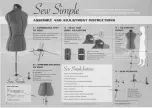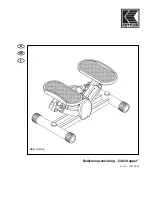
Modification mode
[12]-6
3. Confirming the modified data
* Quit the modification mode.
Press to return to the Standard
screen.
(When is pressed,
the modifications executed last will be
undone.)
4. Confirming with the Standard screen
* The stitching start position has been
modified.
(*1)
Memo Please note that there is a characteristic explained as follows about " Modifying the stitching
start position “ of the data with the back tacking. (There is a difference of the operation at the
case of the B data and the BA data.)
The data of the figure below is the straight line data which puts the start/end back tacking of V
mode. (A fat part is back tacking).
In this case, is sewn in order of A
→
B
→
C
→
D.
Therefore, the actual stitch starting position is "A point." (Starting location of the data origination
(input) is "B point."
A
D
C
B
[For the BA data] Please specify whether to correct the A point because work holder
automatically moves to "Actual stitch starting position (A)" when enters to "
Modifying the stitching start position “
[ For B the data ] Please specify whether to correct the B point because “ Starting location (B)
at the data input " after work holder automatically moves to "Actual stitch
starting position (A)" when enters to " Modifying the stitching start position “
Summary of Contents for PLK-E Series
Page 2: ......
Page 13: ...Explanations of basic screens keys and operations 3 6...
Page 15: ...Stitching data type and writing No 4 1...
Page 21: ...Reading writing and erasing data floppy disk 5 5...
Page 26: ...Reading writing and erasing data internal memory 6 4...
Page 28: ...7 1...
Page 35: ...Creating simple stitching data 8 6...
Page 39: ...Methods of creating stitching data 9 3...
Page 44: ...Methods of creating stitching data 9 7...
Page 54: ...Methods of creating stitching data 9 15...
Page 58: ...Methods of creating stitching data 9 22...
Page 63: ...Methods of creating stitching data 9 26...
Page 68: ...Methods of creating stitching data 9 30...
Page 72: ...Methods of creating stitching data 9 33...
Page 75: ...Methods of creating stitching data 9 35...
Page 79: ...Methods of creating stitching data 9 38...
Page 86: ...Modification mode 12 5...
Page 89: ...Modification mode 12 7...
Page 94: ...Modification mode 12 11...
Page 99: ...Modification mode 12 15...
Page 104: ...Modification mode 12 19...
Page 111: ...Modification mode 12 25...
Page 115: ...Modification mode 12 28...
Page 122: ...Modification mode 12 34...
Page 126: ...Modification mode 12 37...
Page 133: ...Modification mode 12 43...
Page 138: ...Modification mode 12 47...
Page 143: ...Modification mode 12 51...
Page 148: ...Modification mode 12 55...
Page 155: ...Data conversion mode 13 6...
Page 158: ...Data conversion mode 13 8...
Page 162: ...Data conversion mode 13 11...
Page 166: ...Data conversion mode 13 14...
Page 169: ...Data conversion mode 13 16...
Page 179: ...Data conversion mode 13 25...
Page 204: ...Program mode 16 5...
Page 205: ...Program mode 16 6...
Page 208: ...Program mode list 17 2...
















































